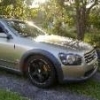Cold Air Intake
Announcements
-
Similar Content
-
Latest Posts
-
That cannot have been a fun set of drilling. The stock "baffle" looks identical to rb26, I just cut fuel cell foam to fit the full length under the baffle.
-
I understand your sarcastic exasperation. But to be fair - the baffles do indeed fit OEM cam covers. They did omit to say that you need to do a bunch of stuff. But they do fit them.
-
Got started on the modification to make these splash plates fit over the long weekend. First the surprisingly time consuming task of swapping all the cam cap bolts to Tomei cam cap studs. I did the method of removing one bolt at a time, applying loctite to the stud, double nutting to torque as the manual described. Then carefully unlocking the nuts without disrupting the torque of the stud (and going back to re-torque a few times when it slipped). Finally applying the nut and torquing to spec. Repeat x28 Next up I went about removing the stock cam cover baffle so I could ensure it was fully clean after drilling for stud clearance. As the blind rivets holding the baffle on were domed I used a punch to mark the center then used 4mm drill bit to carefully drill out the rivet without going too far part the baffle. As seen in other thread here is what is inside the stock baffles I decided on M4x6mm bolts to bolt the baffle plate back on with. I used a 3.3mm drill bit with some tape to mark the depth at ~8mm. Next was to tap the threads using a cheap bunnings kit M4x0.7. With the baffle removed I also drilled out the spot welds holding in the baffle plate oil returns. Unsure whether this was the best option or if I should have cut holes in the Hypertune splash plates to allow the oil drains to still function... time will tell. I then removed the the Hypertune splash plates so I could rest the cam cover on top and use a dab of grease to mark where the studs impacted the oem cam cover baffle. The most obvious spot was on the hump from the stock mesh is held. Using this hole as an anchor I bolted the oem baffle plate back into the cam cover and lined up the Hypertune splash plate. Marked the rest of the holes for the studs and drill those out too. Total 32 holes drilled and 12 threads tapped on the passenger side cam cover alone for this bolt on part that totally clears all OEM cam covers.. Drivers side next as well as some E85 safe fuel foam to fill the space behind the behind cam cover baffle plates. oh and some lock nuts for the splash plates of course.





Recommended Posts
Create an account or sign in to comment
You need to be a member in order to leave a comment
Create an account
Sign up for a new account in our community. It's easy!
Register a new accountSign in
Already have an account? Sign in here.
Sign In Now